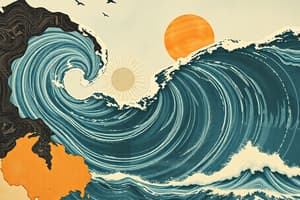Podcast
Questions and Answers
How does the Coriolis effect influence both atmospheric and oceanic movement?
How does the Coriolis effect influence both atmospheric and oceanic movement?
- It causes air and ocean currents to move directly from the poles to the Equator, creating a uniform climate.
- It primarily affects the vertical movement of air and water, with minimal impact on lateral movement.
- It stabilizes the atmosphere and ocean, preventing significant movement of air and water masses.
- It deflects air and ocean currents, causing them to move westward along the Equator and changing direction at different latitudes. (correct)
Which factor, in addition to temperature, significantly affects the density of seawater and drives thermohaline circulation?
Which factor, in addition to temperature, significantly affects the density of seawater and drives thermohaline circulation?
- The proximity to underwater volcanic activity.
- The amount of sunlight absorbed by the water.
- The pressure exerted by the atmosphere on the water's surface.
- The salinity, or the amount of dissolved particles, in the water. (correct)
How does the release of latent heat from cooling water masses impact regional climates?
How does the release of latent heat from cooling water masses impact regional climates?
- It has minimal impact on regional climates, as the heat is quickly dispersed into the atmosphere.
- It moderates the temperature of nearby land masses, contributing to relatively temperate climates. (correct)
- It decreases the overall temperature of nearby land masses, leading to colder climates.
- It increases the frequency of extreme weather events, such as hurricanes and typhoons.
Considering the principles of thermohaline circulation, what would you expect to happen to a warm, salty current as it moves from the Equator towards the poles?
Considering the principles of thermohaline circulation, what would you expect to happen to a warm, salty current as it moves from the Equator towards the poles?
Why is understanding fluid dynamics, such as air and water circulation, essential for predicting climate patterns and weather events?
Why is understanding fluid dynamics, such as air and water circulation, essential for predicting climate patterns and weather events?
Flashcards
Circulation
Circulation
Air and water move across the planet due to density differences and Earth's rotation.
Coriolis Effect
Coriolis Effect
The deflection of air and water movement due to Earth's rotation.
Rising and Sinking
Rising and Sinking
Warm fluids rise, and cool fluids sink due to density differences.
Sea Water Salinity
Sea Water Salinity
Signup and view all the flashcards
Thermohaline Circulation
Thermohaline Circulation
Signup and view all the flashcards
Study Notes
- Earth's surface is covered with fluids, air and water, separated by density.
- Dense, cold waters are at the bottom, and thin, light air masses are at the top, meeting space.
- Circulation refers to the movement of air and water, driven by many variables across the planet.
The Coriolis Effect
- Gases and water are forced into motion because the Earth is a spinning ball.
- Air is pulled along as Earth rotates east, but slower than the planet.
- Air seems to move westward along the Equator, changing direction at different latitudes.
- The Coriolis effect is the deflection of air due to Earth's rotation.
- The effect also applies to ocean surface currents, deflecting them along the Equator and creating westward movement.
Rising and Sinking
- Air and water masses rise and sink vertically because of temperature differences.
- Warm fluids rise, and cool fluids sink.
- Vertical and lateral air movement creates cells of circulating air, causing consistent wind patterns.
- Fluid composition affects density.
- Seawater salinity measures the dissolved particles or 'saltiness' of the water.
- Higher salinity means denser water.
- The densest water on Earth is very cold and very salty.
- Thermohaline circulation is a system of currents driven by changes in temperature ('thermo') and salinity ('haline'), causing vertical water movement.
- Evaporation at the Equator leaves saltier water behind, changing the water's density.
- Warm currents moving towards the poles cool off, increasing density and causing currents to sink.
- Latent heat is released as a water mass cools, impacting the climate of nearby land masses.
- Great Britain has a temperate climate due to the warm Gulf Stream current.
- The Gulf Stream runs along the US East Coast, cools in the North Atlantic, and releases latent heat, warming Northwestern Europe..
- Changes in thermohaline circulation have marked extreme and rapid climate changes throughout Earth's history.
Land
- Surface currents would flow consistently without land masses.
- Continents deflect surface currents.
- Atmospheric circulation is influenced by land masses.
- Land reflects heat, while water absorbs it, due to differences in conductivity.
- Air masses rise and sink with temperature changes caused by land or water.
- Glider pilots analyze these changes, riding updrafts over warm land and downdrafts over cool water.
Ocean Circulation and Climate Change
- The Gulf Stream influences the climate of the southeastern United States and western Europe.
- Warm water from the Gulf of Mexico moves to the North Atlantic, cools, sinks, and returns south through the South Atlantic.
- Melting ice sheets add freshwater while the ocean warms, resulting in less dense freshwater that inhibits sinking.
- The Gulf Stream is weakening due to ocean warming from global climate change.
- Scientists believe that the Gulf Stream could collapse completely.
- Collapse of the Gulf Stream would cause sea level rise in cities such as Miami.
- Increase storms and temperatures in Western Europe if the gulf stream collapses.
Studying That Suits You
Use AI to generate personalized quizzes and flashcards to suit your learning preferences.




